Clickfunnels vs Kajabi is a tough call between two sales funnel builders that could rocket your business – whether it is online courses, digital products, coaching, or even physical products.
As ever, neither software will help you unless you have a compelling product people actually want. However, the speed and ease of Clickfunnels and Kajabi means you can test, iterate and improve your product very rapidly to maximize your chance of success.
Stop hesitating and over-planning your launch based on assumptions like how many pre-launch email signups you have or finding your perfect audience. Build, launch and improve. Many a mistake was made by standing still.
If you need help with launching your online course, membership sites or just generally haven’t quite figures out your sales funnel yet, we highly recommend signing up to the Clickfunnels Funnel Challenge that will get you set up in just 30 days and ready to sell with expert coaching.
In the previous installments of our head-to-head comparative reviews, we’ve had quite a few David-vs-Goliath bouts. To be honest, the underdog has snatched the win under the reigning champ’s nose more than once.
Now, however, the question is if Kajabi, a SAAS solution developed primarily to build and market webinars and online courses, will survive in any of the following rounds against the colossus ClickFunnels.
After his 1986 match against Garry Kasparov, English GM Tony Miles called his opponent “a monster with a thousand eyes who sees all”. In the field of online marketing, ClickFunnels also seems to have at least a thousand eyes. It has a tool, a native app, or an integration to facilitate any sort of online business one can possibly think of.
As its name suggests, ClickFunnels will help you build as many sales funnels as you need and your leads and customers will be clicking frantically to check them out one after the other. However, ClickFunnels’ landing page building capabilities are not to be underestimated either.
I am also curious if the reigning champion because several fellow reviewers have already declared ClickFunnels the best online marketing platform of 2020, is going to beat Kajabi on its own turf – webinar and online course building and marketing. But first, let’s learn a bit more about our two contenders’ background.
Kajabi vs Clickfunnels – About Kajabi
Kenny Rueter, Travis Rosser founded Kajabi in 2010 in Irvine, California. They wanted to provide an all-in-one online platform that could help entrepreneurs, experts, and influencers grow their businesses.
In the beginning, Travis did all the heavy lifting to give Kajabi a successful liftoff – design, branding, products, software design, you name it. However, at some time in 2018, he started to feel a bit out of place in the company, and in 2018 he parted ways with Kenny. This became known as “The big Kajabi Breakup.
Anyway, the important thing is that Travis’s legacy is still alive. In addition to creating membership sites and online courses, Kajabi can automate your email marketing campaigns for a variety of products – from digital products and courses to physical products. On the platform, you can also create and edit professionally-looking landing pages.
If you’d like to better connect with your customers, then Kajabi’s CRM tool is going to gather all of your customers into one homogenous community on your terms. The company’s team are so confident in their features and tools that they proudly declare: “Kajabi is everything you need, no plugins or integrations required”.
Well, let’s see if that’s really the case, or they just mean to say that their product integrates with only a handful of third-party apps. Well, Kajabi’s boldness certainly does not end there. They go on to assert that they can build sales funnels that can make you migrate to their platform from ClickFunnels. So, it won’t be an overstatement to say that Kajabi is our boldest and most aggressive challenger so far!
Kajabi vs Clickfunnels – A Word about The Champion
As I said, ClickFunnels tops the list of this year’s best online marketing platforms, and for a good reason. By the way, I don’t remember seeing Kajabi among the shortlisted contenders.
When Russell Brunson and Todd Dickerson founded ClickFunnels in 2014, they relied mostly on their own money to get the company going. It seems that Russell had already come up with his original idea of a sales funnel, and ClickFunnels was the place where he built the first prototypes from scratch.
ClickFunnels is also one of the fairest online marketing platforms out there. Their landing page abounds in short lead-in videos that’ll help you understand the difference between a sales funnel and an ordinary website.
This does not mean that you can’t set up an ordinary webpage from your ClickFunnels account. Quite of the contrary – their intuitive drag-and-drop editor called Etison will get the job done for you in just a few minutes.
In addition, ClickFunnels’s AI-powered autoresponder called Actionetics will help you turn all of that traffic to your website into a loyal group of returning customers.
Just like ClickFunnels, Kajabi offers a shopping cart. However, that of ClickFunnels has got a button for an immediate upsell. What I mean is that Kajabi may have as many features and tools as ClickFunnels or even a little more.
However, the tools that ClickFunnels offers are intelligent and easy to use, as well as efficient. On top of that, they seem to be cheaper than Kajabi’s. And I am going to prove that in the following paragraphs, so read on!
ClickFunnels vs Kajabi: Features
Within the word count of this review, it is impossible to compare Kajabi and ClickFunnels feature by feature and tool by tool. We can, however, grab the bull by the horns and start with the most heatedly contested one.
Kajabi vs Clickfunnels Sales Funnels
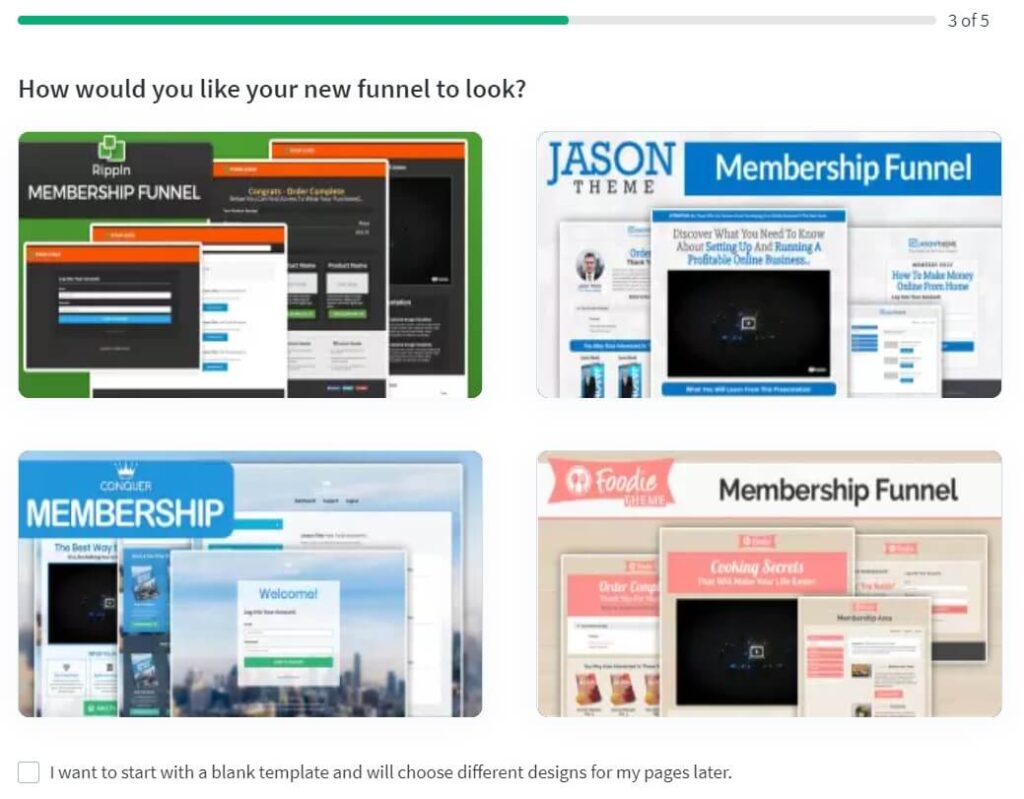
When you challenge a monster like Clickfunnels on its home turf, you’ve got to at least try to explain in what way your product is better. Kajabi’s pipelines are not sufficiently explained on the platform’s official website.
Fellow marketers have shared that the most tangible difference between Kajabi and ClickFunnels’ sales funnels and automation tools is that all of Kajabi’s pipelines come with pre-written email templates for every step of the sales process.
Each email contains a professionally-sounding copy that you can edit, or use as it is. Team Kajabi go on to downgrade ClickFunnel’s “blank funnel” option, slamming it as too complicated and time-consuming to populate.
Kajabi’s most popular and highest-converting sales pipelines are grouped in what the company calls Opt-in, Value, Offer (OVO). From your Kajabi account, you can create different Pipeline blueprints (funnel templates), depending on the type of your online business.
Kajabi says that OVO pipelines’ primary purpose is to grab your audience’s interest and make them sign up for your content or product, whether that be physical or digital products. You can choose from one of the following OVO pipelines, including those for:
- Life coaching
- Giveaway campaigns
- Sales
- Product launching
- Webinars
- E-book promotions
To create a new sales pipeline in your Kajabi account, you should first click on the Marketing Tab. Then, you should click on “Pipelines”, and then on “New Pipeline”.
From there, you have to choose a blueprint (or a template as we call it) that best represents your business and watch the embedded tutorial video on how to best use it.
I wonder if there’s anything that has left unshared about the mighty funnel building capabilities. Their obvious advantage over Kajabi’s pipelines is that you can start creating one from scratch.
But this is only the beginning. Basically, you can start building your first funnel using the platform’s Classic Funnel Builder.
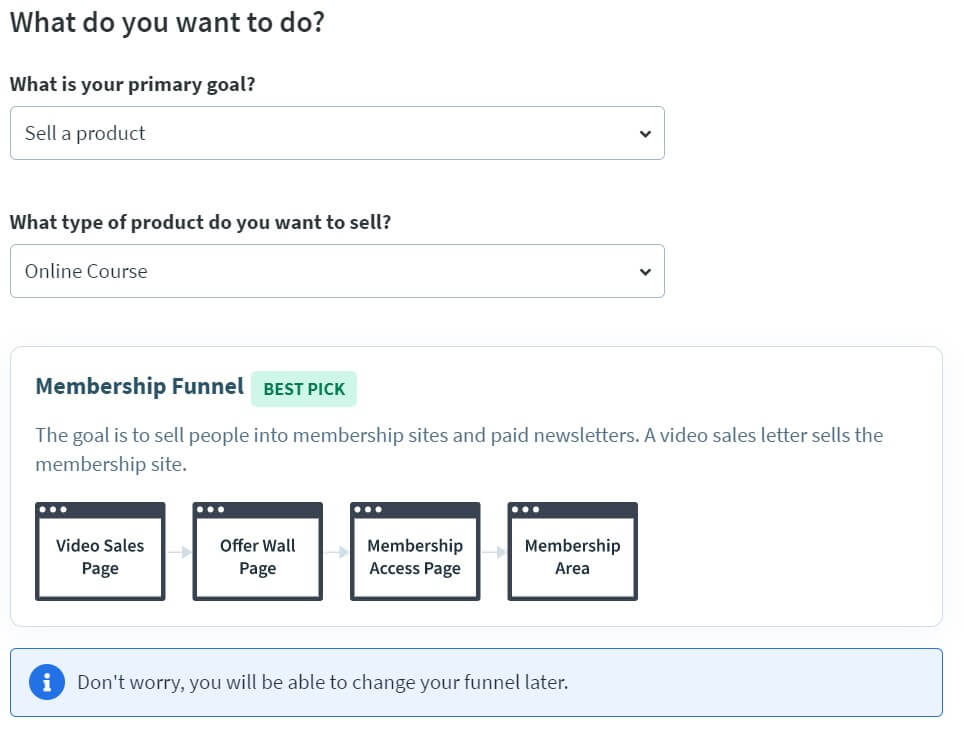
As a first step, you select your funnel’s goal. You’ve got three options: collect emails, host a webinar, or sell a product. Under each option, you’ll see a number of funnel templates you can choose from. You can also add a “Thank You” page and also choose from a wide variety of available templates.
On ClickFunnels, you can also use their Funnel Cookbook in order to set you a sales pipeline. You see, having two funnel building options at hand is always better. The big difference between the Classic Funnel Builder and the Cookbook is that you can download the latter onto your computer.
In the Cookbook, you can choose from a really vast number of businesses to position your funnel into. Compared to Kajabi, ClickFunnels’ templates cover a far larger number of different industries: B2B, e-commerce, marketing, etc. However, your choice is narrowed down by the specific goal you’ve selected in the previous stage.
Once you pick up the template that best corresponds to your business vision, you can proceed to watch the embedded tutorial videos for further setup tips. And this is only one example of why ClickFunnels’ sales pipelines are much more popular than Kajabi’s. But, as Freddie Mercury sings, “The show must go on…”
Clickfunnels and Kajabi Landing Pages
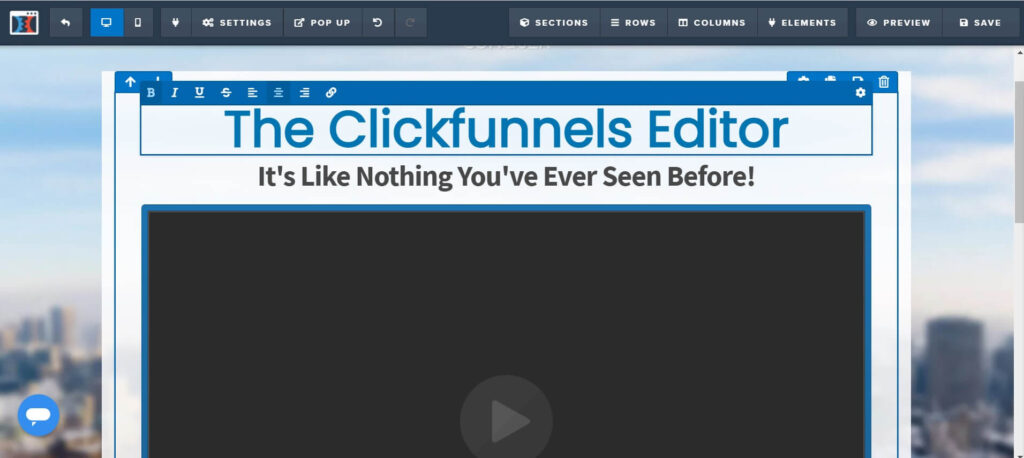
In the second round of the Kajabi vs ClickFunnels match, we are going to compare the fighters’ drag and drop page building tools.
On ClickFunnels, you start building a new sales pipeline as explained above and then set “Collect Emails” as its goal. After naming your funnel, you should proceed to select “Group Tags” and then choose the Landing Pages subcategory.
You can use one of the templates in the library, or build a page from scratch. You can start editing your page by clicking the respective button in the drag and drop editor.
Once completed, you can use an advanced page setting called SEO Meta Data to make your page discoverable by Google. This advanced feature is to be found in the Settings drop-down menu. Should you need to launch email campaigns from your page, you can use ClickFunnels’ native autoresponder service called Actionetics, or integrate a third-party email service such as Aweber or GetResponse.
On the whole, it would have been much better if ClickFunnels had separated their sales funnel builder from their page editor, but the whole point of Clickfunnels is packaging everything into marketing funnels. Let us now check what Kajabi has to offer.
Regardless of which of Kajabi’s three pricing plans you’re going to choose, you’ll be able to build an unlimited number of landing pages.
From the platform’s official website, we learnt that their page builder is easy to use and that its user interface (UI) is very intuitive. They also say that their pre-built website templates can accommodate virtually any business.
Kajabi’s templates are also fully customizable and all of their elements can be rearranged as per the user’s ideas and views. This statement implies that Kajabi’s webpage creator is of the drag-and-drop type, but we could not find official confirmation on their home page. There’s also a mention of custom domains on Kajabi’s official website, but the information is rather sketchy.
On the whole, the platform’s website building capabilities are described rather superfluously, which does not create a feeling of reassurance in the future user. There are no explanatory videos or step-by-step tutorials either. Therefore, ClickFunnels wins this round as well.
Clickfunnels and Kajabi Marketing Automations
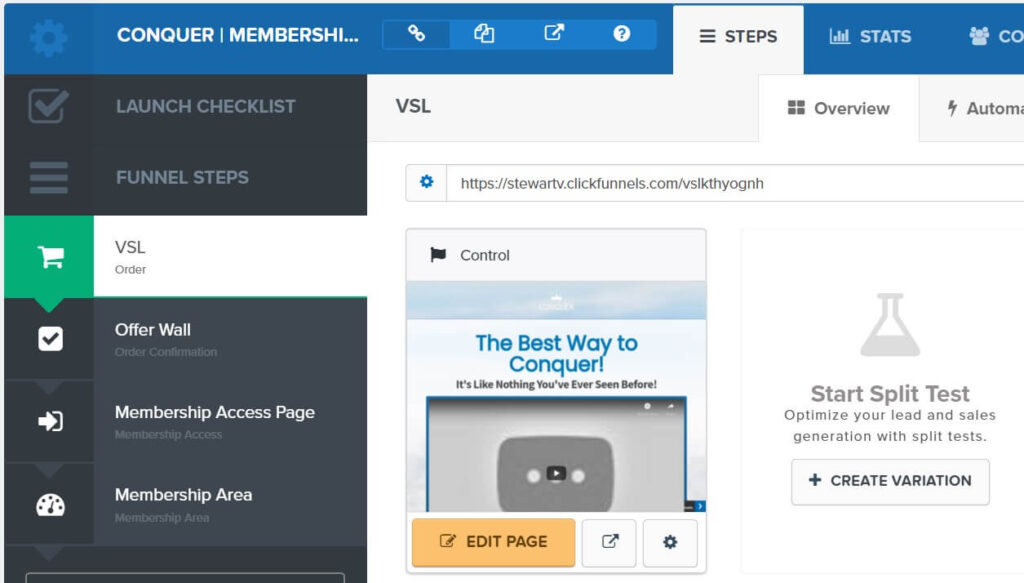
The next round of the ClickFunnels vs Kajabi match is dedicated to their marketing automation tools. Here we should emphasize that none of the platforms specializes in email marketing as opposed to powerful sales funnels. Therefore, the round promises to be really exciting.
If you’d like to learn how to create new automation in your sales funnel, just visit the respective section of ClickFunnels’s website and follow the steps described.
Each step is accompanied by an appropriate screenshot for better visibility. The whole layout of the automations page creates a feeling in the visitor that they have come to the right place.
With the help of The Simple Mail Transfer Protocol (SMTP) service, you can send marketing emails directly from your ClickFunnels account.
To automate your campaign, first, click on “Add New Email”. Then, you should give your newly-created email form an appropriate name and a subject line.
Next, you have to select the most appropriate SMTP configuration. This may sound complicated, but the embedded tutorial video will make it simple.
After that, you have to set a condition that’d trigger the email. In a few similar steps, you’ll be able to set up an SMS text automation. Also, the trigger actions can automatically be set off at specific times.
Email marketing automations are only available on Kajabi’s more expensive plans – Growth and Pro. In Kajabi’s Help Center, you can find a useful step-by-step guide to automations. On the whole, they are easy to set up, but it’s important to remember that only the Growth and Pro plans allow you to create automations with conditionals on Kajabi.
In a nutshell, these conditionals allow you to set strictly specific “if conditions” under which an automated action is triggered. From the Marketing tab in your Kajabi account, you can also create email marketing automations for an unsent email sequence or an email broadcast.
From what we could see on both Kajabi’s and Clickfunnels’s websites regarding email marketing, both platforms perform equally well in this field. So, this third round appears to be a draw.
Clickfunnels and Kajabi Reporting and Analytics
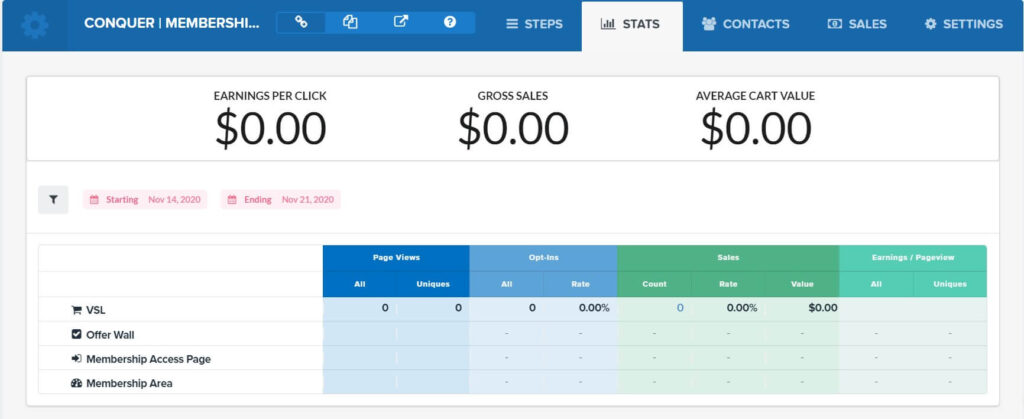
At Kajabi, they take reporting and analytics quite seriously. Visit their Help Center and you’ll be able to watch a tutorial video on the subject that’s over 17 minutes long.
To access the neatly organized dashboard, you just have to click on the Website tab, and then on “Analytics”. The three main indexes you are going to see are the following:
- Net revenue for the past month
- All-time revenue
- Number of completed purchases for the past month
The Recent Activity Sidebar shows the number of billed subscriptions, requested refunds, and the total charges. The Reports page of Kajabi also provides a glimpse of your affiliate commissions and offer purchases, as well as the progress your members are making in each product category.
Now, let’s see what ClickFunnels has to offer against Kajabi’s reporting capabilities. Rather than generating comprehensive reports on the performance of your entire online business, ClickFunnels offers a stats report for each of your sales funnels. Info on how to access these stats is available on the company’s website.
To see just the stats that are relevant to your small business, you can apply different filters. Should you need more precise reports, you can always integrate Google Analytics into your ClickFunnels account. However, I feel that Kajabi wins the fourth round by a unanimous decision.
A/B Testing
The sixth round of the Kajabi vs Clickfunnels bout is dedicated to split testing. Split tests let you compare two versions of a landing page or two email marketing forms against certain criteria and use the winner in your campaigns.
On Clickfunnels, you can go into any of your sales funnels and split test their elements like opt-in pages and so on.
You can create a duplicate opt-in form, make minor edits to it, and compare it to the original, or create a brand-new opt-in form from a template.
The winner in every split test depends on the traffic that the new version or the original version generates. On the whole, ClickFunnels’s split tests are easy to use and simple to implement.
Kajabi does not have a native split testing tool. To perform a split test, you have to create two versions of your page and paste the respective links into different social media campaigns or email segments of your contacts.
After some time, you should manually check the traffic generated by each page. This is done from the Analytics dashboard in your account.
Alternatively, you can use some free a/b testing tools like Google Optimize or paid ones like Optimizely to test your Kajabi pages. Both Kajabi and Clickfunnels appear to be shaky when it comes to split tests.
Because ClickFunnels has got an integrated a/b testing tool and Kajabi hasn’t, the reigning champion snatches the win in the fifth round.
Pricing

Now, let’s look at the pricing options that Kajabi and ClickFunnels offer. As you begin scrolling down ClickFunnels’s front page, you’ll be encouraged to start a 14-day free trial on several occasions. We don’t like the fact that the pricing section isn’t easily discoverable on their website.
If you’ve been following our posts for some time now, you probably know that ClickFunnels offers three plans: Basic, Platinum, and Two Coma X. The cheapest plan costs just $97 per month and includes a pretty decent bundle of features – 20 funnels, 100 pages, one secondary user account, three payment gateways, 3 domains, and customer support via chat.
The Platinum Plan allows you to set up an unlimited number of sales funnels, pages, and follow-up funnels. It also provides 3 secondary accounts, 9 payment gateways, and 9 domains. The price is $297 per month and includes priority customer support.
The exclusive Two Coma X Club is for people who make more than $1,000,000 a year in their sales funnels. Suffice it to say that it costs $2,497/mo. Obviously, this plan does not include a free trial.
Although smaller and less powerful than ClickFunnels in more than one respect, Kajabi appears to be the more expensive of the two platforms. If billed annually, its basic plan costs $119 per month. Its features, however, appear quite limited.
For example, it allows you to list just three products, create three pipelines and one website, and manage them from a single admin account. The nicest thing is that this plan lets you have 10,000 contacts in your list, but only 1,000 active members.
The Growth Plan costs $159/mo, if paid for the whole year, and includes a list with 15 products, 15 sales funnels, 10 admin accounts, 25,000 contacts, 10,000 active members but, again, only one website. Interestingly, both the Basic and the Growth plans let you send an unlimited number of email marketing messages.
There is no cap on the number of landing pages you can set up either. Regarding customer support, Kajabi’s basic plan provides live chat support, but you have to observe the agents’ office hours. The Growth Plan includes 24/7 customer service.
The Pro Plan costs $319 per month if paid for 12 months, and it’s for individuals who are serious about developing a stable and sustainable online business. It allows you to list 100 products and sell them through 100 pipelines. There’s no limit to the number of landing pages you can create, but the number of marketing emails you can send per month has been limited to two million. You can also create a massive 100,000-strong contact list and have up to 20,000 active members and three websites. They can be managed by up to 25 admin users.
For the untrained eye, ClickFunnels may appear cheaper than Kajabi. However, you should also consider the fact that the challenger’s most expensive plan is rather affordable compared to ClickFunnels’s elite pricing option. Because of its better feature-per-dollar ratio, I’d give the win in this final round to Kajabi.
Final Verdict
The fact that Kajabi obviously lost this head-to-head comparison isn’t that important. The important thing is that by challenging a giant like ClickFunnels, Kajabi got in the limelight and attracted the attention of potential users. It also drew blood from the reigning champion in at least two rounds. Nice try, Kajabi, and good luck in the next match!
